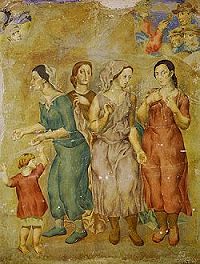
Women, Fresco, 1934, 220 x 180 cm,
Reina Sophia Museum, Madrid
(photograph before restoration).
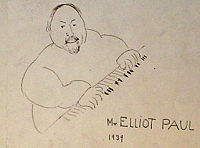
pencil sketch on paper (1939) of Eliot Paul by
his close friend Luis Quintanilla
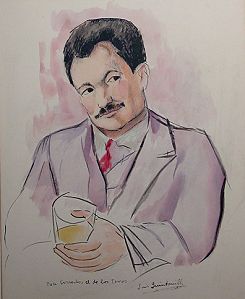
Luis Quintanilla
Ernest Hemingway in Madrid in 1931 Watercolor, 15 1/2 x 20 1/2," painted from memory in New York, 1950s
Examples of the works included in the group of Quintanilla prints brought to the
United States by Ernest Hemingway
for exhibition at the
Pierre Matisse Gallery, New York,1934,
to raise money for the imprisoned artist

Calle de Madrid evocanda a Goya
(Madrid Street Scene Evoking Goya)
Drypoint
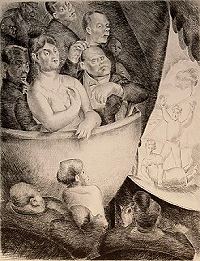
Teatro Burgues
(Bourgeois Theater)
Drypoint
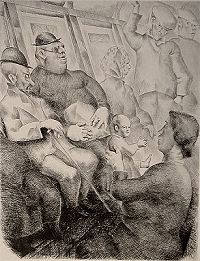
Interior de un tranvia en Madrid
(Interior of a Streetcar in Madrid)
Drypoint
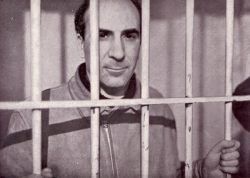
Luis Quintanilla in prison in Madrid, 1934
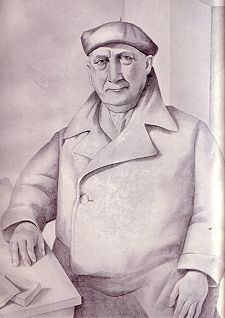
Francisco Largo Caballero
(Minister of Labor and later Prime Minister)
drawn by Quintanilla while in jail, 1934,
pencil on paper 26 x 37cm (sheet)
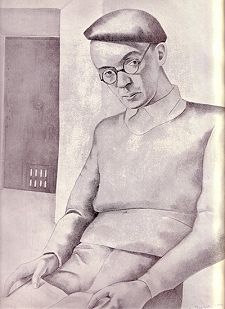
Julian Zugazagoitia
(Minister of the Interior during the war)
drawn by Quintanilla while in jail, 1934,
pencil on paper 26 x 37cm (sheet)

Catalogue Cover from the exhibition at
the Pierre Matisse Gallery to raise money for
the imprisoned artist
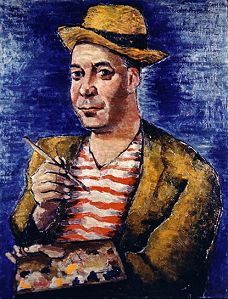
Luis Quintanilla
John Dos Passos as a Sunday Painter
oil on canvas; Oil on Canvas, c. 1943
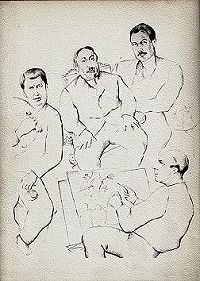
Pencil sketch of the artist drawing
his friends (left to right), Jay Allen, Eliot Paul ,
and Ernest Hemingway.
(This illustration was reproduced from All the Brave, the collection of drawings of the Spanish Civil War, which the four men portrayed participated in creating).
|
Notes
(The following are not included in the original text of Waiting at the Shore.except where noted)
|
| 1. Juan Negrin was born in Las Palmas de Gran Canaria, became a university professor of physiology and physician, was named Minister of Finance for the Second Republic in September, 1936, in the government of Fancisco Largo Cabalerro, and in May, 1937, became President of the Second Republic. (Wikipedia). |
| 2. Angel Sanchez Rivero (Madrid, 1888-1930), philosopher, art critic, director of the Department of Fine Arts at the Biblioteca Nacional de España, friend, and mentor of Luis Quintanilla in Madrid during the 1920's and 1930's.
It was "under Sanchez Rivero's tutelage [that Quintanilla] studied the library's great collection of prints . . . including many Rembrandts, Goyas and Durers, actually holding the precious [works] in his hands. And when he became especially enthusiastic over one of [them], Sanchez Rivero would interrupt his [own] studies to join [Quintanilla]. 'Listening to him speak' [Quintanilla tells us in his memoirs] 'increased in me that starnge pleasure which artistic emotions create in us, feeling the mysterious, transcendent miracle that lines, rhythms, and the contrast of simple blacks and whites can transport us to an ideal world: that fantastic, mystical and human engraving of Rembrandt's entitled The Hundred Florins, the audacities and ironies of Goya in his Caprichos and Proverbs, and the concentrated philosophical unrest of Durer.' [ from Quintanilla, Luis. Pasatiempo]" (Quintanilla, Paul. Waiting, I 61.)
Furthermore, it was under the encouragement of Sanchez Rivero that Quintanilla began to "grabar a la punta seca" (make drypoints) with Adolfo Ruperez. (Quintanilla, Paul. Waiting, I 84.)
|
| 3. Elliot Paul (1891-1958) was a prolific American author and close friend of Quintanilla both in Spain and later in New York. His works, several of which were illustrated by Quintanilla, include fiction, journalism, mysteries, memoirs, sreenplays, film criticism, and a history of jazz. |
| 4. Lester Ziffren and Jay Allen -- American friends of Quintanilla, and Hemingway, Ziffren was the United Press Correspondent in Spain, 19933-36; Allen the correspondent for the Chicago Tribune, which fired him for his pro-Republic stance. |
| 5. Waiting at the Shore by Paul Quintanilla is avialable in it's entirety from Lulu Press. |
|
1. A Time of Dreams [This and the prefaces to the Pierre Matisse Gallery Catalogue, "Quintanilla," by Ernest Hemingway and John Dos Passos (See below.) are reprinted from Chapter IX, "The Republic" of Waiting at the Shore, a biography of Luis Quintanilla, by Paul Quintanilla]
Toward the end of that first summer of the Republic [Madrid, 1931], a time of dreams and hope for the future, my father finished the frescoes for the Casa del Pueblo and the panels were permanently hung in the Conference Hall. Several prominent Socialists appeared at the inaugural, including Francisco Largo Caballero and Julian Besteiro. So did Miguel de Unamuno, Ramon del Valle Inclan, and Jose Ortega y Gasset. But Madrid's professional art critics stayed away and the critic of his own party's newspaper, El Socialista, "didn't skimp in making vituperative remarks about my mediocrity as an artist." [All quotations from Luis Quintanilla, unless otherwise specified, are from Pasatiempo, the artist's memoirs.] Sometime later, though, Miguel Utrillo, the critic and art historian who gave his name to the famous painter of Montmartre street scenes, wrote a lengthy appraisal in which he argued that the frescoes "were the only good things being done at the time in Madrid with a modern tendency."
My father was nearly flat broke once again, but that "providential fairy who protects artists," interceded, once again, and he won a national prize which provided him with several thousand pesetas. And through Juan Negrin, he obtained a commission to paint the murals for the new Administration Building of the University City.
After two and a half months the frescoes were finished, which depicted "the misfortunes and disgraces of poverty and ignorance as opposed to the benefits of modern science." And once again the critics' comments were, for the most part, unfavorable. When Ernest Hemingway came to see them he was amused by the appearance of a siphon bottle, the natural accompaniment back in the thirties to a cocktail shaker, among the laboratory equipment portrayed up on the panels. And Ernesto asked my father if siphon bottles were required in scientific research? The bottle had been included to represent Negrin, who frequently employed such a device and was known among some of his friends as "Doctor Sifon." And from then on my father would occasionally add a siphon bottle to his work as a memento of Juan Negrin and "as the symbol, according to Hemingway, of modern scientific research." Then he went on to paint the murals for the entry hall to Madrid's Museum of Modern Art.
We can only judge the frescoes he did at this time from a few black and white photographs which still survive, for nearly all the murals he painted in public places were destroyed by the war or by the Fascists after the war. Angel Sanchez Rivero had remarked, though, that photographs are a "slander" against his work, for it possessed "the virtue of not being a photogenic art." And in these ancient photographs the impressions which are created tend to be somewhat harsh and crude, recalling the "proletarian" art of the thirties. But one fresco still survives: a
small panel from the entrance hall to Madrid's Museum of Modern Art, which was restored by the Ministry of Culture sometime in the late seventies. The figures possess a somewhat Italianate classicism, combining a variety of moods, as if Pompeii had somehow mixed with modern Spain and the industrial age. But the rhythms in this mural are extremely powerful, the colors beautiful and brilliant, and even in a photograph this all somehow becomes discernable. And there is nothing "proletarian" or harsh about this one remaining mural, for the women in the foreground appear very Spanish, classical and modern all at the same time, the end result being, I think, that it is simply a beautiful mural, for all time.
With the architect Esteban de la Mora and the sculptor Emiliano Barral he entered into a competition to design and decorate the monument to Pablo Iglesias, the founder of Spain's Socialist Party. Madrid's Ayuntamiento put up 600,000 pesetas for the project and it was my father's intention that instead of constructing "montones de piedras," mountains of stone, with numerous sculpted figures, "a simple porch in a beautiful and tranquil setting where visitors could quietly contemplate the benefits Pablo Iglesias had left behind" would be more appropriate. And while awaiting the outcome of the competition he travelled through Andalucia with the elderly wife of Emile Vandervelde, the leader of Belgium's Socialist Party and sometimes Premier, and in Granada they visited the home of Manuel de Falla, Madame Vandervelde's friend. And having agreed to trade a drawing for each drink she bought on the way, he did the portrait of de Falla for Madame Vandervelde in his sketch book. Then, with an unidentified girlfriend, he toured Morocco and when he returned to Madrid painted another fresco for the University City and with these new funds went off to visit Elliot Paul on the Island of Ibiza.
A man who enjoyed enjoying himself, Elliot organized many fiestas and banquets, entertaining by playing his accordion and other instruments, and had become so popular with the local Ibizanos that my father proposed making him the mayor of Santa Eulalia, the small town he and Flora and Peanut lived in. "Everything was peace," we are told, "on that happy island, and the people were tolerant and amiable." Elliot asked him to paint "various things," including a portrait of the two village idiots, who would only sit still if he, Elliot, played the accordion for them. And as my father painted and Elliot played his accordion they could hear the hotel owner's pigs grunting in the background as they foraged for food. And far from the fierce pace of modern city life, Elliot and my father spent their days undisturbed in a calm and creative atmosphere. Then my father received word from Madrid that their project had won the competition.
Esteban de la Mora began to oversee the construction of the large monument which would be in Madrid's Parque del Oeste. And my father began to draw the preliminary outlines for the monument's eleven frescoes. These, he tells us, depicted the "prominent events in the life of that austere self-taught man, typesetter, and great organizer, who dedicated his life to improving the well-being of the working class following Socialist lines, who was even respected by his most fanatical enemies and detractors among the bourgeoisie."
At about this time the Museum of Modern Art of Madrid inaugurated a new hall for the graphic arts with a show of Rembrandt's engravings. These were the same drawings my father had studied under the tutelage of Sanchez Rivero in the National Library. When the show came to an end the museum's Director, Juan de la Encina, suggested that he show his own engravings next. My father balked at the idea for he had never shown any of them before except to a few close friends whose opinions, he suspected, might be biased. And thought that a show of his drawings on top of the Rembrandts could be "audacious."
In the spring of 1934 forty of these engravings of Madrid street scenes and life were shown and the reaction, it appears, surprised everyone, especially my father. For the first time the professional art critics wrote extensively about his work and large crowds of visitors began to appear at the show. It was with these engravings that his name first began to become widely known and the first comparisons to Goya were made. These were the etchings that Hemingway and Dos Passos became so excited about. Even now, I still have the engravings, in their original paper wrapping, Hemingway picked out for himself, known to us in the family as "the Hemingway Collection," which inspired him to exclaim that they were: "the first true Madrid we have seen since Goya." And though my father considered himself first and foremost a muralist there have been those critics over the years who have thought his graphic work superior to his painting. Fortunately, a good deal of that early graphic work still survives. And it was as a Spanish artist, perhaps even as a Madrid artist, that he was emerging, with a uniquely personal aesthetic vision of his own. And whether it was the gray grit of the street or common domestic intimacies within an ordinary household, Madrid in the thirties poetically appears in these long forgotten etchings. For isn't it the power of reality which is the great driving force behind any artistic expression?
In the meantime the porch for the Monument to the Memory of Pablo Iglesias was completed and my father set about to work on the frescoes. "We had placed it in the Parque del Oeste, one of the most beautiful spots in Madrid. It only took me ten minutes to walk through the park from my home to the monument in the early morning, this contact with the beauty of nature helping to awaken me and to enliven my eagerness to work. And, truly, I placed my highest illusions in this work for a number of reasons: the murals' theme, their popular purpose, the chance to give form to my ideas, and even the location of the monument in an isolated garden, with its perfume of the magnolia trees and the songs of the blackbirds and nightingales. We constructed a studio made of wood which we could move along the length of the frescoes and in this manner I painted tranquilly without being disturbed by the curious. It took me about ten days to paint each fresco, and I would then rest three or four days before starting the next one. Painting within this rhythm of alternating work and rest I had completed four panels when circumstances imposed a parenthesis within my artistic labors which lasted several months. And I knew an experience which ordinarily doesn't occur in life and which stamps its permanent mark." Note: The experience he refers to here is of being thrown into jail.
2. The Revolution of 1934
On the night of the fifth of October, nineteen thirty four, my father was arrested in his studio for being a member of the Revolutionary Committee which had intended to overthrow the Madrid government. He was taken a mere short block away to the Carcel Modelo where, with a sizeable group of politicians, intellectuals, and workers, he was locked up to await trial. And though once again more sympathetically than actively involved he had indeed hosted a large group of revolutionaries who were awaiting the moment when they would go out onto the streets to oust the central government: though when the police arrived he vigorously protested they had all gathered in his studio merely to look at art.
What had provoked these revolutionary activities on the left was a decisive move on the part of the central government toward the far right. "The first republican who was opposed to the Republic," my father tells us, "was the President of the Republic," Don Niceto Alcala Zamora, who didn't view the Republic as a "fundamental change in philosophy" but simply as "a change in who holds the power." Under the Socialist attorney Luis Jimenez de Asua the Republic wrote a constitution which guaranteed the freedoms of speech, assembly, and of the press. Women were given the right to vote and Largo Caballero, the Minister of Labor, signed into law a minimum wage, paid holidays and sick leaves, the eight hour day and fair mechanisms to settle labor disputes. Manual Azana, the new Minister of War, attempted to reduce the overbloated officer corps by offering the generals early retirement at full pay. Agrarian reforms were cautiously initiated, with a modest redistribution of those lands belonging to the aristocracy among the peasants who worked them. And Article 26 of the new constitution called for the separation of church and state: government financial aid to the Church was eliminated, education was removed from parochial schools and placed into public schools, divorce and civil marriages were allowed for the first time, and the Church became subject to the law like any other civil or religious institution.
The reaction on the part of the right was a howl of persecution and reactionary devout Catholics enlisted into such emerging rightwing organizations as Jose Maria Gil Robles Accion Popular, which combined traditional Catholic beliefs with the Fascist doctrines which were circulating then about Europe. Jose Antonio Primo de Rivera, the son of the military dictator, formed the Falange, an overtly Fascist organization and the more reactionary aristocrats and monarchists were drawn toward such groups as Renovacion Espanola under Antonio Goicoechea and Jose Calvo Sotelo. And as Calvo Sotelo performed his "patriotic duties" as an elected deputy in the Cortes, Spain's national parliament, he secretly began to plot with Mussolini for the overthrow of the Republic while General Sanjurjo visited the Winter Olympics in Berlin in order to trade Spain's iron ore for the Fuhrer's support.
After the brief respite of hope and promise, when the founders of the Republic had hoped the new government would be able to correct the accumulated abuses and injustices of centuries, those reactionary forces which had only recently been ousted began to emerge again. And the entrenched privileged classes illustrated, once again, the attitude they had so often displayed in the past even toward the most simple and fundamentally fair reforms. They would not budge an inch. Elections were held in November 1933 and the right was better organized now, brought together by Gil Robles into a coalition known as the CEDA. And since the Anarchists, being anarchists, refused to vote and the women, having been given the right to vote, tended to be devoutly Roman Catholic the left lost its majority in the Cortes. Alejandro Lerroux became the Republic's new Prime Minister and when in September 1934 he appointed three members of the rightwing CEDA to ministerial posts, with the blessings of Generals Franco and Goded, the parties of the left believed they had to act.
Having lunch one afternoon with Largo Caballero and Juan Negrin in a restaurant just outside Madrid, Largo explained the threats which were emerging against the Republic, and directing himself toward my father said: "You too can become active. Remember what you saw of the Fascists in Italy."
His "sporting spirit" thus awakened, he and Indalecio Prieto helped move several boxes of pistols, machineguns, and hand grenades from one hiding place to another in Madrid and, he tells us, his sporting sense "didn't lack in emotion" as they traversed the city several times in various cars full of arms. Due to the strategic location of his studio, with its terrace overlooking the heart of Madrid, the leaders of the revolution chose it to be their command post. At the beginning of October a general strike began and for several days the capital was paralyzed by street fighting. The government declared a "state of war" and General Franco led his troops against the people of Madrid who held the major streets and plazas. My father's job then was to act as an intermediary in the distribution of arms to the revolutionaries. On the fifth night of the revolt, the fifth of October, Santiago Carillo and several prominent directors of the UGT, the Socialist Youth, and two labor unions (my father didn't identify the directors: could it be because Franco was still alive?), were in the studio awaiting the moment when they would go out onto the streets. They had idled the day away by making and consuming an enormous paella and at about ten o'clock that night my father went to bed. "Brief was my repose," he tells us. The police arrived shortly after he turned off the lights.
What had given their presence away was a lapse among some of the more youthful members of the committee who had gone out onto the studio's terrace to discuss the day's events, and a neighbor overheard them and reported them to the police. When they arrived the police were astonished by the importance of some of the leaders they discovered. "Whether it was due to the professional excitement of making an important arrest or because they thought we might react with violence, the police became extremely nervous, holding their rifles on us in a threatening manner." And though I doubt my father ever intended to use it, he had a pistol tucked under his belt which he quickly hid in a planter out on the terrace. Searching everywhere, including the planters, the police never found the gun but discovered instead four pistols Julio Alvarez del Vayo had inadvertently left behind in the library before leaving earlier that evening. Indicating the importance of their arrest, the Commissioner of Police soon arrived. And in a very gentle manner told my father: "Close everything up very tight, friend Quintanilla, for you can see for yourself where you are all
going."
3. The Show at the Pierre Matisse Gallery
As has happened on other occasions when a prominent artist has found himself in jail the world's intellectual community immediately rallied to his aid. Andre Malraux organized the protests and circulated the petitions in France. Lady Margo Asquith, the wife of the former Prime Minister, did the same in England. And in the United States Ernest Hemingway and John Dos Passos arranged to have forty of the Madrid street-scene
etchings displayed at the Pierre Matisse Gallery in New York. Ernesto paid for the show and for having the prints pulled and along with Dos Passos wrote the catalog. He also arranged for a picket line to parade back and forth before the Spanish consulate in New York. The Consul, Antonio de la Cruz Marin, was a good friend of my father's and allowed the picketers to march undisturbed, dispatching telegrams back to the Madrid central government informing them that on the first day more than two hundred picketers appeared, on the second more than six hundred, and on the third there were more than a thousand. A "fabrication," my father quietly adds, for "in New York at that time there weren't that many people who were disposed to waste their time, in the cold, marching on the street for some unknown, even if they were asked to by Hemingway."
Dos and Hemingway wrote to several well-known writers and artists, including Edmund Wilson, Henri Matisse, Theodore Dreiser, Sinclair Lewis, Thomas Mann, "and a few people of no definite political color," as Dos Passos put it, to rally their support. "One of my best pals," Hemingway wrote Arnold Gingrich, "is having a show of his etchings at the Pierre Matisse gallery in the Fuller Bldg... . The etchings are damned wonderful, the finest dry points I've ever-seen by anybody alive... Do you know anybody you can steam up to go and see it or anybody who buys etchings in New York you could get to go and see these? The stuff is no charity business nor helping out a pal. They're simply bloody marvelous. If you've got twenty bucks to spend you ought to buy one. The money all goes to Quintanilla except twenty percent to Pierre Matisse as dealer. Pierre is all worked up about them and thinks they're marvelous. I know damned well they are but because I'm his pal I might be supposed to be prejudiced."
"Say, Malcolm," Dos Passos wrote Malcolm Cowley, "on Nov 20th at the Pierre Matisse Gallery on E. 57th Street there's going to be an exposition of etchings by Luis Quintanilla. I think he's a great etcher. He's a hell of a good guy and is at present in jail as a member of the Madrid revolutionary committee - if you like the stuff, please try to get the boys to go to bat for it, articles and stuff like that. I'm hoping that if he's hailed as Spain's best etcher which he is - in the great line of Goya etc it may be possible to circulate a petition of some kind that might induce the Spanish gov't to go a little easy on him. Anyway Quintanilla's work is damn good and he's a wonderful guy and everybody ought to do everything they can to get him out."Within only a few weeks after his arrest those smart New Yorkers who desired an intimate glimpse of Madrid street life could visit the Pierre Matisse Gallery to examine the etchings. The show ran from November 20 to December 4 and its catalog was a small, glossy, twice-folded sheet which reproduced an etching of two Madrid working men in workingman's caps, very black and gray and evocative of old Madrid. [See Emigrantes] In that small cramped space the quality of the artistry could have perhaps been lost but, nevertheless, that dark reproduction strongly evoked the aesthetic qualities of the original, which was so Spanish and foreign to anything about New York, in spite of the American city's great cosmopolitanism. Hemingway and Dos Passos, I believe, were deeply aware of this disparity and a sense of it vividly appears in what they had to write for the catalog. There is also something poignantly evocative of the "old days" in what they said: those "old days"when they could get together after work for a beer, to calmly talk and laugh, in a tavern or cafe, when they were all merely artists together living day to day within the slow and patient creation of their work and politics was a distant activity engaged in a world far away. When unwritten and unpainted dreams could dominate their lives and fill their hearts with hope. For there is also something very impassioned and bitter about their comments. Hemingway's came first.
Preface by Ernest Hemingway
If this exposition of dry points by Luis Quintanilla had been two months ago, the list of patrons would have been headed by His Excellency the Spanish Ambassador, His Excellency the American Ambassador to Spain and followed by other dignitaries and names of people.
As it is there are no patrons, the artist is in jail in Madrid charged with being a member of the revolutionary committee of the October revolt in Spain with the prosecuting attorney asking a sentence of sixteen years at hard labor for him, and the only excellencies are in these magnificent etchings.
Good Spanish painters are always in trouble. It is a country where the tradition is, and it may be a foolish tradition, I will not argue it with you, that a man should be a man as well as an artist. Velazquez, with the least brains and no ambition but to paint and be respectable, had servant trouble. He tried to be, too well, the perfect servant of royalty and it killed him, finally. Goya's troubles came, mostly, from what he carried between his thighs and they were fairly continuous, very interesting to study, and sometimes seem unnecessary. But the necessary misfortunes we never make ourselves.
If we omit the Greek who, not being a Spaniard, cannot be judged by his trouble, which was religion, there are no other really good ones until Picasso and Juan Gris. Picasso has been in grave trouble for a number of years now through money and the desire for money. Juan Gris died in great trouble over the self-imposed lack of it. Miro's trouble is quite complicated yet very simple and he could do with a little more of it; and now here is Quintanilla in trouble with revolution.
On the day, a not dull day, that I had a cable in Havana from two friends in Madrid saying in a clearly decipherable yet mystifying to a censor, impromptu code, "Luis hoosegowed," signed Ziff Allen, I received, forwarded in the mail, a mimeographed sheet entitled, The Event of the Year, which event was a literary tea to be given at the studio of someone for the guest pickets of the Macaulay Company. The invitation to be present, to picket and to proceed to the self-styled literary tea was signed by a man who, since two years, cannot write fifty consecutive words without using the word revolution.
Now this may possibly be a good time to suggest that a small tax be levied on the use of the word revolution, the proceeds to be given to the defense of, say, such people as Luis Quintanilla, or any of your friends who are in jail, by all those who write the word and never have shot nor been shot at; who never have stored arms nor filled a bomb, nor have discovered arms nor had a bomb burst among them; who never have gone hungry in a general strike, nor have manned streetcars when the tracks are dynamited; who never have sought cover in a street trying to get their heads behind a gutter; who never have seen a woman shot in the head, in the breast or in the buttocks; who never have seen an old man with the top of his head off; who never have walked with their hands up; who never have shot a horse or seen hooves smash a head; who never have sat a horse and been shot at or stoned; who never have been cracked on the head with a club nor have thrown a brick; who never have seen a scab's forearms broken with a crow-bar, or an agitator filled up with compressed air with an air hose; who, now it gets more serious - that is, the penalty is more severe - have never moved a load of arms at night in a big city; nor standing, seeing it moved, knowing what it was and afraid to denounce it because they did not want to die later; nor (let's end it, it could go on too long) stood on a roof trying to urinate on their hands to wash off the black in the fork between finger and thumb from the back-spit of a Thompson gun, the gun thrown in a cistern and the troops coming up the stairs: the hands are what they judge you by - the hands are all the evidence they need although they won't acquit you on them being clean if they are sure of the roof; nor even came up with the troops.
No. The word revolution should be taxed, and guest pickets, if they wish to speak it at the Event of the Year, should wear a celluloid badge, something like a hunting license, showing they have paid for the privilege,
Luis Quintanilla, who has the right to use that word, is very sparing of it. He does not take the money and rant to save his soul like Diego Rivera. He has painted great frescoes in the Casa del Pueblo and the Ciudad Universitario in Madrid and there are no symbols of capitalism, or any symbols in them. Always there are people as there are people in the etchings. He does not judge them; only presents them because he has led them in action. If you follow you idealize. If you have led you present and criticize, you have the right to satirize, and when you hate, you hate intelligently.
Quintanilla in whose apartment the arms were stored when it was not known that it would be a bloodless revolution that sent out Alfonso, Quintanilla who raised the republican flag over the royal palace, climbing up and running it up with his own hands before it was certain there was an abdication, and who took no credit and never let it be referred to without joking, where he would have been embalmed in school books if it had been an American revolution; this Quintanilla draws with a sharp instrument on nickled zinc to make etchings that are beautiful and lasting in any epoch at any time; etchings that can speak familiarly with thee and thou, without affectation of comradeship, by merit, with any etcher that has ever lived. And I believe that those who use the word revolution easily, too easily, to save their souls or to make a career, should pay a small tax to those who have a right to shout it as they were supposed to shout and sound horns in the north of that country a long time ago.
But those who truly have a right to use that word, through exposition of their bodies and their liberty, speak very quietly, do their other work (and all good work goes to the same end) well; and when they are in jail write that they are quite comfortable, with good people, not at all discouraged, ask how you are and how are the children, naming them, and is the hunting season good, better than this time last year when we were in Extremadura after wild boar (he wrote before that in November and December he would be in Holland, very good pictures there and in Belgium on the way) but he is very well in jail and I will write and tell him all the news, really in jail it is very funny.
So there, like a moving cloud, comes the shadow of sixteen years of a fine artist's life (from thirty-nine to fifty-five that makes) that the state asks to take away. So here are the etchings. Take a good look at them. It is your luck to see them, and to have them, because the man who made them might as well-have been in jail or killed two years ago when they put the Bourbon out. But that was a good one, that one succeeded. So a man had time to work, to make this world, and scratch it on nickled zinc a line at a time, a million lines, that make a world where there is light and depth and space, humor, pity and understanding, and a sound earthy knowledge that gives us the first true Madrid we have seen since Goya.
Now he is in jail and the great frescoes he was making for the monument to Pablo Iglesias will not be completed. This last revolution it seems was a bad one; not like the good one that brought honor and the chance to work. A good one, you know, is one that succeeds. A bad one is one that fails.
You who read the catalogue are all right, you know. You must not feel badly. Do not let it disturb you. Madrid is a long way away and you never heard of this man before. What did he get in trouble for anyway?
Sure. That is the way to look at it. But look at the etchings. Take a good look at the etchings.
Preface by John Dos Passos
Here's something very different from the export-Spain of the art galleries and cruise folders. No high combs or modish mantillas or singers of La Violetera dressed up for Holy Week. Here are the back lots, the cheap whores, the beggars and bootblacks, and the new business men greedy for power. This stuff of Quintanilla is different, too, from the work of the brilliant Spaniards of the school of Paris. This is a Spaniard who stayed at home, instead of moving out to peddle the magnificent Iberian tradition of design in the safe world of international Ritz. For a man who can see and feel it's always more dangerous at home.
Staying at home it was natural that he should be a satirist; most of the best Spaniards have been satirists. There's a type of clear noontime logic in the Spanish blood that can only come out as satire. The sharp metal cleanness of etching is particularly attractive to the eye and hand of a satirist. A satirist is a man who can't see filth, oppression, the complacency of the powerful, the degradation of the weak without crying out in disgust. A great satirist can turn disgust into violent explosive beauty. Quintanilla has expressed his disgust in etchings and as an active revolutionist. It is natural that the civil and religious bureaucrats, the landlords and industrial exploiters who have used the army, the politicians-on-the-make and particularly those faithful watchdogs of property, the Civil Guards, to get back power in Spain for property, should have put him in jail. Looking at his etchings it is hard to avoid drawing a parallel with Georg Grosz's early work in Germany. The political moment too is similar, a time of defeat of everything that gives men hope.
For inventors of images and designs for the eye or the ear or that amalgam of feelings and sensations that writing appeals to defeat is sometimes better than victory. A good thing, too, because there's a great deal more of it. There's been many a good work started in jail. We can only hope that that honorable ex-republican, ex-radical, ex-firebrand, Mr. Lerroux, is letting Quintanilla have pencils and paper.
You can't add much to work that's meant for the eye by talking about it. There are the etchings themselves on the walls to look at. Good etchings are so rare that there's no mistaking them. You feel in them the sharpness of the tools and the acid, the clean elegance of the metal. In Quintanilla's there's a nightmarish fantasy about the contours that calls up the black Spain of Goya, and a new palpable balanced density that, unless I'm very much mistaken, is something quite fresh in etching. Perhaps it comes from having healthily digested the pure visual experiments of Cezanne and the Cubists. The hardest thing to take, and the best quality in them, is their terrible sanity and clear balance. The few people who care for painting or drawing in our time have come to look for and enjoy childish fancy in an artist, entertaining twilight insanities in work that will look charming in a room decorated with modern furniture at the cocktail hour. The clear expression of a clean eye and an uncluttered grown-up mind is something much more dangerous and explosive. These etchings offer no amusing escapes to the tired artlovers. They are the statement of a grown-up man facing a bitter world in the sun at noon. [See note 5.]
|